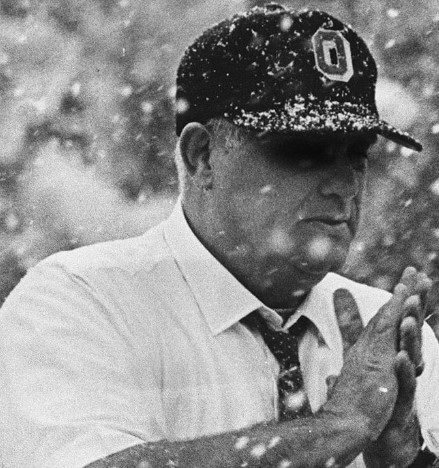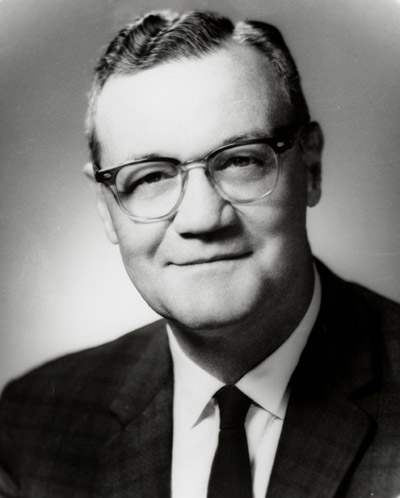|
Football Short Story
Woody's Salvation - Part 1
1968: The Year That Saved Ohio State Football, David Hyde (2008)
Preface
As the 1968 season loomed, Ohio State Coach Woody Hayes was coming off his second losing season in 17 years as Buckeye head coach. During the 1967 Ohio State football season, "Goodbye Woody" banners were sold before games and dragged from airplanes during them.
Booster donations, always a barometer of a coach's future, were down $500,000 that year. Hayes was hanged in effigy, and at one rally players attended, the effigy was burned.
As if this weren't unsettling enough, there were volatile behind-the-scenes issues, too. Hayes's famous temper had erupted in the Iowa game during the 1966 season. He hit an Iowa player on the sideline. Or grabbed him. Or something. It wasn't captured on television or film. It didn't make the newspapers. It happened so quickly many inside the team didn't even know about it, or think anything of it, because everyone on the inside knew Hayes's fists could be fast.
  L-R: Woody Hayes, Dick Larkins It was news, however, to prominent university officials. Athletic director Dick Larkins entered the football office the following Monday morning and met with much of the coaching staff. He didn't bother to take off his coat. He was shaking, he was so nervous.
"Woody," Larkins said, "the Athletic Council has met and asked for your resignation."
Hayes didn't flinch. "Is that all you have?" he asked.
Larkins nodded.
"Okay, you go back to the Athletic Council, tell them I'm not resigning and that they're wasting my time," Hayes said.
Larry Catuzzi, a young assistant, observed the give-and-take across the table that morning in silent shock. But what happened after Larkins left and apparently took the news back to the Athletic Council was even more stunning: Nothing. No firing. No resignation. No mention of it again to the staff. Nothing but business as usual.
Still, no one felt comfortable at the direction of the program. Mallory, who had arrived as an assistant for that 1966 season, thought by this next winter that he had made a mistake in taking the job, and he wasn't alone. Earle Bruce arrived on the coaching staff at the same time as Mallory and was surprised by the team's low level of talent. He thought he'd left better players behind at Massillon High School. It all came back, Bruce figured, to the lifeblood of any program: recruiting.
Some of the recruiting problems stemmed from a 1961 Rose Bowl bid that Ohio State turned down because its faculty committee feared the school was becoming a football factory. Hayes was irate after that vote. Protests were held. The Columbus Dispatch even printed the addresses and phone numbers of the faculty committee members who promptly found loud segments of the city shouting in their yards.
"That hurt us for years," Hayes once said. "All the recruits from other schools had to tell a boy was, `Go to Ohio State and you'll never play in the Rose Bowl."'
nother problem was more practical: Ohio State's recruiting was a mess of tactical disorganization and lost opportunity. Esco Sarkkinen, for example, recruited the fertile football ground of Cleveland's Catholic league. Sarkkinen was a good coach and legendary Ohio State name. But he wasn't Catholic. And he didn't drive a car. Graduate assistants picked him up for work each morning at his home and drove him into the office. Either his wife drove him on recruiting trips or he took a plane and taxis. Needless to say, Sarkkinen neither soothed some parents' faith-based concerns nor spent enough time working the area.
In 1966, Lou McCullough, who headed Ohio State's recruiting, proposed four fundamental changes that had an immediate effect: 1) He would schedule Woody Hayes's recruiting visits to organize his time and take full advantage of his presence; 2) The recruiting base would be expanded beyond Ohio for special players; 3) He would move Sarkkinen to the more driver-friendly central Ohio region; and 4) He would hire Catuzzi.
Catuzzi was the kind of coach this staff lacked, McCullough knew. At 26, he was young, smart, and carried himself well. He had the eastern contacts of a New Jersey native and a Catholic-family background that no other assistant did. When McCullough brought up the idea, Woody Hayes shouted, "Catuzzi, Catuzzi, what the hell kind of name is Catuzzi?"
Catuzzi was the kind of coach this staff lacked, McCullough knew. At 26, he was young, smart, and carried himself well. He had the eastern contacts of a New Jersey native and a Catholic-family background that no other assistant did. When McCullough brought up the idea, Woody Hayes shouted, "Catuzzi, Catuzzi, what the hell kind of name is Catuzzi?"
"A good, Italian-Catholic boy," McCullough said.
Catuzzi had been marked as a rising star in the coaching universe, so much so that he was the only assistant retained from Indiana's fired staff that winter of 1966. Still, Notre Dame was trying to hire him away from Indiana when Hayes called him. They set up an 11:30 a.m. meeting at the football offices in St. John Arena. Catuzzi arrived at the arena with five minutes to spare but couldn't find an unlocked door. He began walking around the arena, looking at his watch, trying not to panic.
"Jee-zus H. Christ, you want to coach my quarterbacks and you can't find an open door!" Hayes said, lightheartedly, when Catuzzi walked into the football office just before noon.
Catuzzi was given a piece of chalk and told to draw up some plays on the chalkboard. A few hours later, he was the newest member of the staff. He was put in charge of the quarterbacks. But it would be recruiting New Jersey, New York, and Cleveland where he would make his biggest impact.
He discovered new lands. He brought home riches.
He became the program's Christopher Columbus.
To be continued ...
|